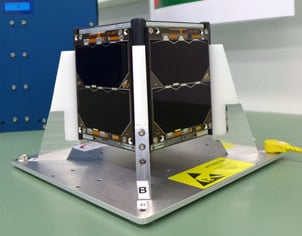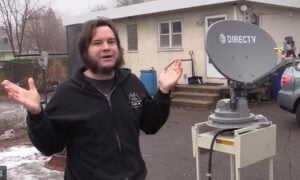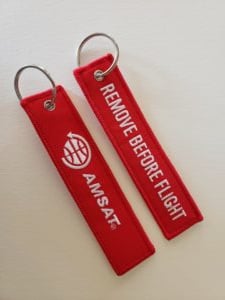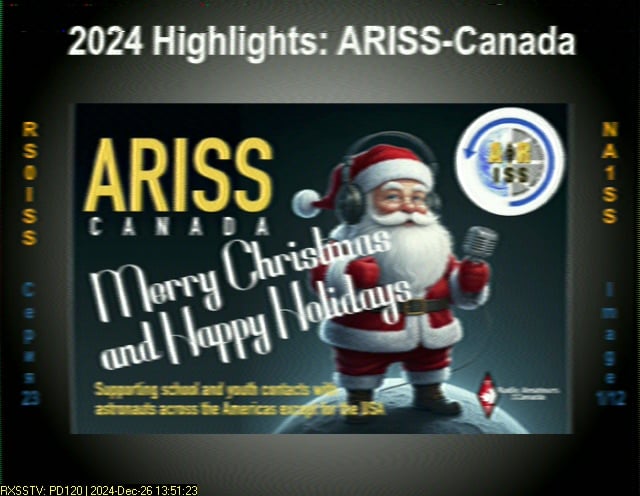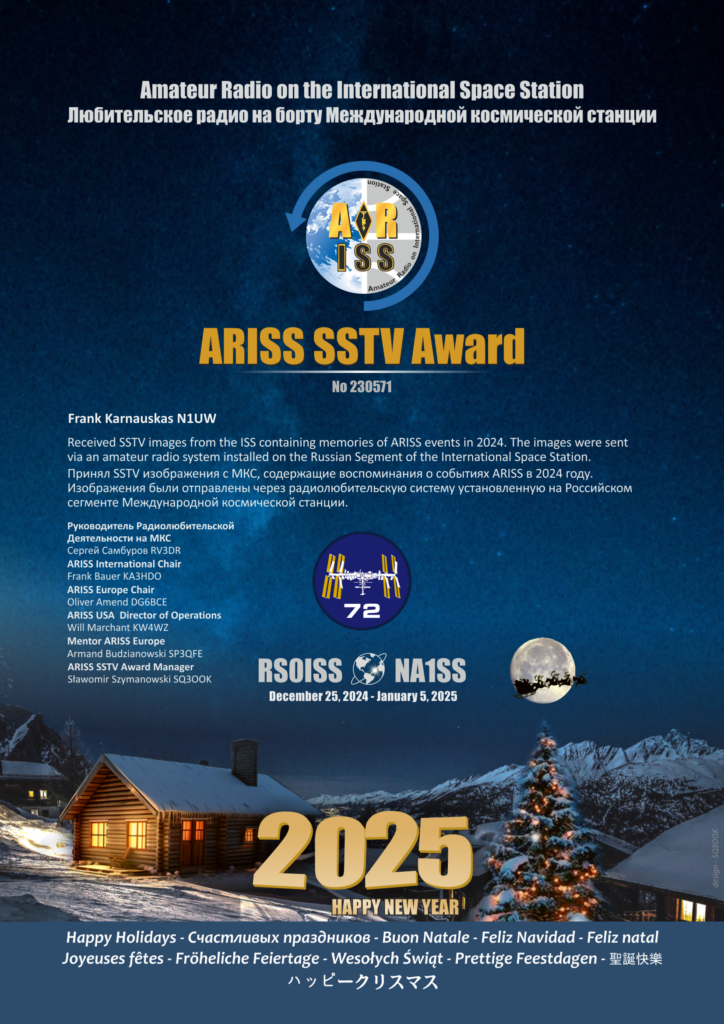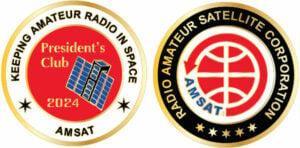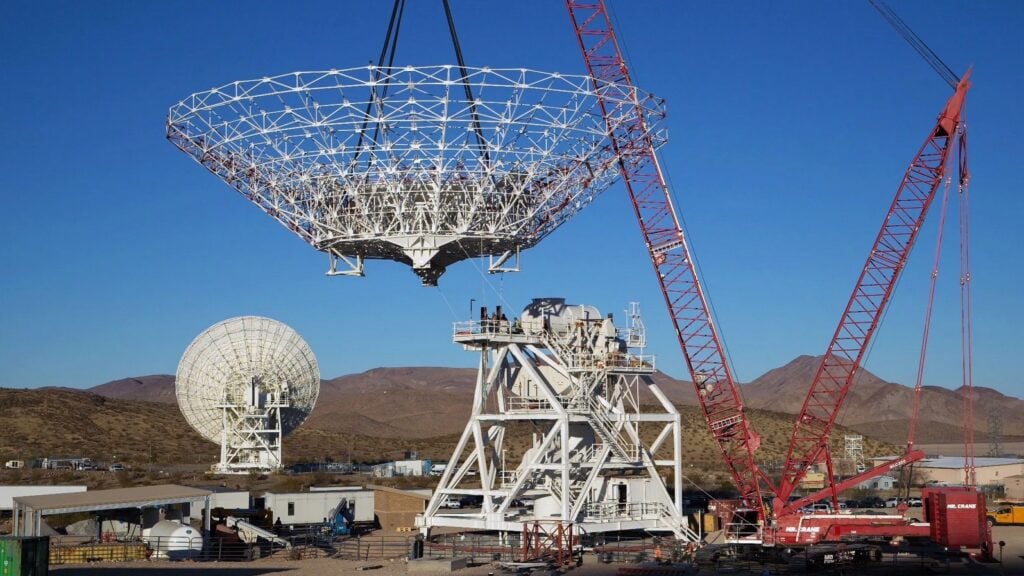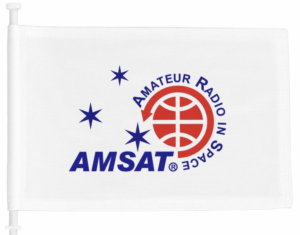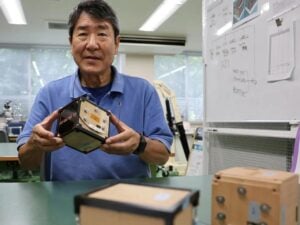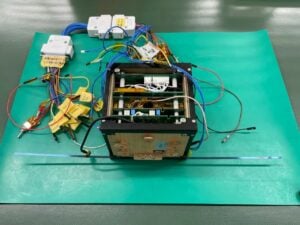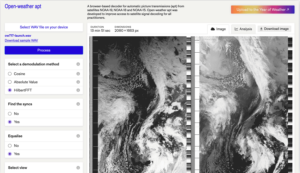AMSAT NEWS SERVICE
ANS-068
In this edition:
- Another Batch of CubeSatSim Kits Available Soon in AMSAT Store
- GOLF-TEE Advances: Flight Software and Bus Status
- New Textbook Featuring GNU Radio Published
- ISS Astronauts Reject Call for Early Retirement of the Station
- VUCC Satellite Standing March 2025
- DXCC Satellite Standing March 2025
- Changes to AMSAT TLE Distribution for March 7, 2025
- ARISS News
- Upcoming Satellite Operations
- AMSAT Ambassador Activities
- Satellite Shorts From All Over
The AMSAT News Service bulletins are a free, weekly news and information service of AMSAT, the Radio Amateur Satellite Corporation. ANS publishes news related to Amateur Radio in Space including reports on the activities of a worldwide group of Amateur Radio operators who share an active interest in designing, building, launching and communicating through analog and digital Amateur Radio satellites.
The news feed on http://www.amsat.org publishes news of Amateur Radio in Space as soon as our volunteers can post it.
Please send any amateur satellite news or reports to: ans-editor [at] amsat [dot] org.
You can sign up for free e-mail delivery of the AMSAT News Service Bulletins via the ANS List; to join this list see: https://mailman.amsat.org/postorius/lists/ans.amsat.org/
ANS-068 AMSAT News Service Weekly Bulletins
To: All RADIO AMATEURS
From: Radio Amateur Satellite Corporation
712 H Street NE, Suite 1653
Washington, DC 20002
DATE 2025 Mar 09
Another Batch of CubeSatSim Kits Available Soon in AMSAT Store
A new batch of twenty CubeSatSim Kits will be available for purchase in the AMSAT Store on Wednesday, March 12, 2025, at 7:00 PM US EDT (2300 UTC). Priced at $400 with shipping included for U.S. addresses, the CubeSatSim Kit offers a hands-on learning experience with no soldering and some assembly, making it ideal for both educational use and public demonstrations.
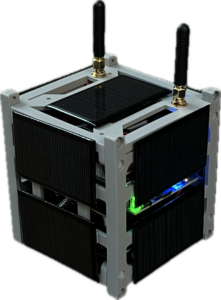
The CubeSatSim Kit includes:
- Fully assembled and tested PCBs (Main, Solar, and Battery Boards)
- Raspberry Pi Zero 2 with a Pi Camera and fully programmed micro-SD card, along with a fully programmed Raspberry Pi Pico WH
- AMSAT logo Remove Before Flight tag switch
- 3D printed frame, nylon screws, and nuts, with a mini screwdriver included for assembly
- Metal standoffs, stacking headers, and JST jumpers for stacking the PCBs and Pi Zero 2
- 10 solar panels with pre-soldered JST connectors and mounting tape
- BME280 sensor (pressure, temperature, altitude, humidity) and MPU6050 IMU/gyro pre-soldered
- Two 6? SMA coax cables and two SMA antennas
The kit also comes with an instruction sheet, parts inventory, and links to online instructions. Assembly time is estimated to be under two hours, with scissors and the provided mini screwdriver.

The v2.0 CubeSatSim features improvements over v1.2, such as an FM transceiver, Raspberry Pi Pico microcontroller, and RF command and control using DTMF or APRS packets. It can also be modified to function as a 500mW high altitude balloon payload.
For those interested in creating their own CubeSatSim, v2.0 blank PCB sets are available at the AMSAT Store for $35. These require additional components, which can be purchased for approximately $300 using the provided Bill of Materials.
Additional resources include:
- Kit Instructions https://cubesatsim.org/kit
- it Videos https://cubesatsim.org/kit-videos
- Discussion Forum https://github.com/alanbjohnston/CubeSatSim/discussions
- Quick Start Guide https://cubesatsim.org/qsg
For more information or to borrow a loaner CubeSat Simulator, contact Alan Johnston, AMSAT VP Educational Relations, at ku2y [at] arrl [dot]net.
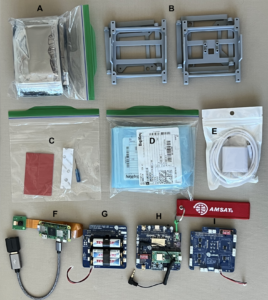
How to Order
Kits will be sold exclusively on the AMSAT Store website.
Only U.S. shipping addresses are eligible; orders with non-U.S. addresses will be refunded and closed.
About CubeSatSim
CubeSatSim is a low-cost satellite emulator powered by solar panels and batteries. It transmits UHF radio telemetry and can be expanded with additional sensors and modules, making it ideal for educational and public demonstrations.
The 2025 AMSAT President’s Club coins are here now!
Celebrating the 40th Anniversary of Amateur Radio on Human Spaceflight
Help Support GOLF and Fox Plus
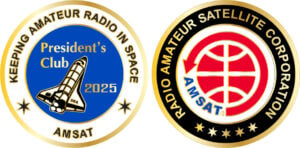
Join the AMSAT President’s Club today and help
Keep Amateur Radio in Space!
https://www.amsat.org/join-the-amsat-presidents-club/
GOLF-TEE Advances: Flight Software and Bus Status
Burns Fisher, WB1FJ recently presented a review of the progress being made on the GOLF-TEE flight software, and an overview of the satellite electrical busses and telemetry.
This next generation of GOLF satellites (Greater Orbit – Larger Footprint) marks a new era of communications satellites. The GOLF series of satellites requires technologies that are new to AMSAT’s CubeSat program. The first satellite of this ambitious effort is called GOLF-TEE for Technology Exploration Environment. As an experimental mission, GOLF-TEE is designed to fly in an readily available and low cost low-earth orbit. Its purpose is to test technologies that will be used in later GOLF satellites.

Fisher showed the audience a new 3D printed model of GOLF-TEE and its circuit board mockups to be secured on aluminum rails. GOLF Project Engineers are optimizing placement of the circuit boards so a model of each board is a big help. They are confronting the challenges that satellite designers face when trying to fit stacks of circuit boards, batteries, complex control systems, and experimental payloads inside a 10cm x 10cm x 30cm spaceframe that is the core of a three-unit CubeSat. He explained that the four fold-out solar panels are expected to generate about 36 Watts of power in full-sun. Fisher commented, “That’s a surprising amount of power.”
But, before GOLF-TEE is ready to fly, several earth-bound versions of the satellite are used by AMSAT engineers. A “flatsat” is a generic term describing the first attempt at interconnecting the circuit boards to be used in the satellite. The components are spread out on a table for easier access to subsystems. At this point, the circuit boards may not even look like what the final items will look like. The flatsat is used for initial testing and development of the circuits as well as the software that runs and communicates with the systems.
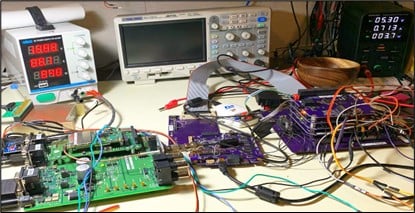
The project uses an AMSAT Linear Transponder Module (LTM) for command/control, telemetry, and a V/U linear transponder as well as a newly designed Radiation-Tolerant processor (the RT-IHU). The satellite will utilize a real-time operating system controlling three microprocessors. He said, “Processor coordination is new to GOLF. It keeps watch over processing monitoring for failures. It copes with failures by switching processors.”
GOLF-TEE uses a number of different electrical busses, including I2c and SPI. The purpose of any bus is to communicate among different electrical units while reducing wiring complexity,
Fisher described the eight software programs, also called tasks, that the Real-Time operating system manages:: Downlink Control; Telemetry Collection; Diagnostic Console; Receiver/Transmitter Control; Commanding; Experiment Control; Processor Coordination; and CAN Support.
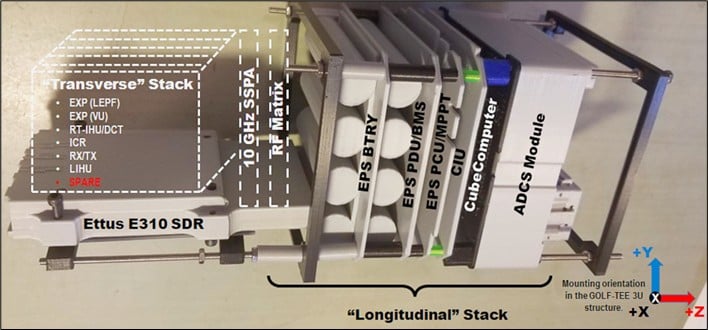
Fisher’s work includes tests of the CAN bus and the Central Interface Unit connecting various subsystems. The CAN bus is a controller area network that is a vehicle bus standard designed to enable efficient communication primarily between electronic control units. The CAN bus is new to the AMSAT CubeSat program.
GOLF-TEE will carry a Vanderbilt University a RadFx (Radiation Effects) experiment using I2C data communication format. Vanderbilt University’s Institute for Space and Defense Electronics analyzes radiation-hardened electronics, develops test methods and plans for assuring radiation hardness, and develops solutions to system-specific problems related to radiation effects.
An upcoming feature of a future GOLF satellite will be the ability to comply with NASA’s Orbital Debris and Collision Avoidance Requirements for satellites flying at higher orbits. This means carrying not only an attitude detection and control system but a possible propulsion system needed to de-orbit the satellite at the end of its useful life.
Burns Fisher credited technical contributions to the program by Chris Thompson, VE2TCP, Rich Gopstein, KD2CQ, and Bill Schell, W2WZ. Fisher is a life member of AMSAT and the volunteer lead flight software developer for GOLF Satellites.
[ANS thanks Burns Fisher, WB1FJ, AMSAT GOLF Lead Flight Software Developer for the above information.]
New Textbook Featuring GNU Radio Published
The GNU Radio community announces the publication of a new textbook dedicated to GNU Radio and its applications. Communication Systems Engineering with GNU Radio: A Hands-on Approach explores a wide range of topics, including RADAR, GNSS reception, satellite communication, and digital communications. This book encapsulates over 12 years of experience working with GNU Radio and provides a structured, hands-on approach for students, educators, and practitioners alike.
Software-defined radio (SDR), which emerged in the 1990s, has become a core development method in certain high-profile fields, including military and space communications. High cost and problems with hardware availability, however, prevented this technology from being widely disseminated. The advent of low-cost hardware beginning in the 2010s, however, has made GNU Radio the leading open-source software toolkit for developing SDR systems an increasingly viable and even critical tool for a new generation of radio frequency communication engineers.
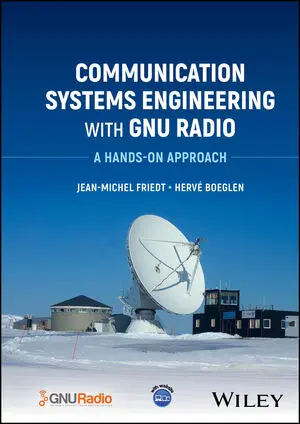
Communication Systems Engineering with GNU Radio provides an accessible overview of this toolkit and its applications. Beginning with the fundamentals of using GNU radio for digital signal processing, the volume then moves to the practicalities of decoding data and the advantages of accessing raw data normally unavailable in hardware-defined radio frequency receivers. The result is a potentially crucial tool for engineers looking to adopt this cost-effective and flexible standard for transmitting and processing radio frequency signals.
Readers will find a careful balance of radio communications theory with GNU Radio practicalities, practical implementation examples employing well-developed open-source GNU Radio platforms and extensive accompanying documentation and explanation.
We also encourage educators looking to connect with the GNU Radio community to join #edu on chat.gnuradio.org, or reach out via email at [email protected].
Communication Systems Engineering with GNU Radio is ideal for graduate and undergraduate students in communications systems courses, as well as professionals working in SDR.
The GNU Radio community extends its gratitude to the authors, Jean-Michel Friedt and Herve Boeglen, for their work making this resource available.
More information is available at https://www.gnuradio.org/news/2025-01-29-gnuradio-textbook.
[ANS thanks gnuradio.org for the above information.]
ISS Astronauts Reject Call for Early Retirement of the Station
Astronauts on the International Space Station said they disagreed with Elon Musk’s claim that the station was past its prime and should be deorbited in as soon as two years.
Speaking to reporters March 4, NASA astronauts Suni Williams, KD5PLB, and Butch Wilmore, who have been on the station since June on a flawed Starliner test flight, and Nick Hague, KG5TMV, the commander of the Crew-9 mission that will bring the two back with him later this month, addressed political issues like an early retirement of the ISS and Musk’s claim he offered NASA an early return of the Starliner crew.
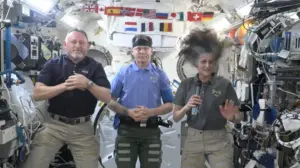
That included comments on social media by Musk on Feb. 20 where he said the ISS “has served its purpose” and has “very little incremental utility.” Musk called for deorbiting the ISS as soon as possible, which he said should be in two years. NASA’s current plans call for operating the ISS to 2030.
“I actually was extremely impressed coming up here and seeing how much science is going on,” Williams said when asked about Musk’s comments. “I would say we’re actually in our prime right now. We’ve got all the power, all the facilities, up and operating.”
“I would think that right now was probably not the right time to call it quits,” she concluded. “We have probably until 2030 in our agreements, and I think that’s probably really accurate, because we should make the most of this space station for our taxpayers and for all of our international partners, and hold our obligations.”
NASA is instead proceeding with its plan announced in August to have Wilmore and Williams return on the Crew-9 Crew Dragon spacecraft, which launched with two empty seats to provide room for their return. NASA did not consider bringing that capsule back early to ensure there would be an overlap with the Crew-10 mission launching as soon as March 12
“When I launched in late September, our planned return date was the end of February,” Hague said. “Given the amount of training that’s required to get a crew ready and the complexities associated with getting a spacecraft ready to launch and operate in space, targeting a March return is pretty much on target.”
Because Williams and Wilmore did not launch as part of a planned Crew Dragon mission, they do not have customized pressure suits, using instead suits either on the station or brought up on cargo spacecraft.
That means, Williams said, they don’t have their names on them like a typical Crew Dragon suit. “But that’s ok. We’re just Butch and Suni and everybody knows who we are by now.”
“We do have Sharpies up here,” Wilmore added, “so my suit might have a name on it.”
[ANS thanks spacenews.com for the above information.]
Need new satellite antennas?
Purchase M2 LEO-Packs from the AMSAT Store.
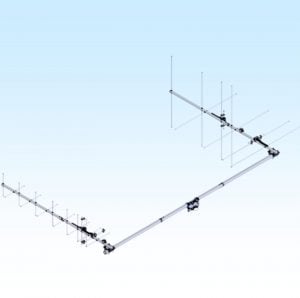
When you purchase through AMSAT, a portion of the proceeds goes towards
Keeping Amateur Radio in Space.
https://amsat.org/product-category/hardware
VUCC Satellite Standing March 2025
VUCC Satellite Award/Endorsement Change Summary for
February 01, 2025 to March 01, 2025.
| Call | Feb. | March |
|---|---|---|
| WC7V1611 | 1619 | |
| F4BKV | 1200 | 1300 |
| YO2CMI | 1003 | 1170 |
| N3GS | 1103 | 1122 |
| JK2XXK | 1086 | 1103 |
| EA2AA | 1026 | 1050 |
| N9FN | 700 | 752 |
| HB9GWJ | 553 | 575 |
| PA7RA | 495 | 534 |
| N8URE(FM19) | 450 | 471 |
| KB3IAI | 358 | 400 |
| DF5SF | 217 | 301 |
| K5WO | 255 | 270 |
| WD5GRW | 205 | 213 |
| WD5GRW(EM13QC) | New | 213 |
| BI4IA | New | 110 |
Congratulations to the new VUCC Satellite holders.
[ANS thanks Jon Goering, N7AZ, for the above information.]
DXCC Satellite Standing March 2025
DXCC Satellite Award/Endorsement Change Summary for
February 01, 2025 to March 01, 2025.
| Call | Feb. | March |
|---|---|---|
| OE9DGV | 213 | 214 |
| HB9BZA | 188 | 196 |
| YO2CMI | 174 | 180 |
| G4GIR | 171 | 172 |
| HB9AOF | 151 | 163 |
| YO2KHK | 156 | 158 |
| HB9RYZ | 153 | 155 |
| F6AOJ | 143 | 145 |
| W0NBC | 124 | 142 |
| A65BR | 112 | 117 |
| LA0FA | 112 | 117 |
| ON6AA | New | 114 |
| TF1A | 103 | 112 |
| DJ7NT | 105 | 110 |
| IK8YTA | 100 | 107 |
| DL6JZ | New | 101 |
| G0MRF | New | 100 |
Congratulations to the new DXCC Satellite holders.
ON6AA is first DXCC Satellite holder from JO11
[ANS thanks Jon Goering, N7AZ, for the above information.]
AMSAT Remove Before Flight Key Tags Now Available
Yes, These are the Real Thing!

Your $20 Donation Goes to Help Fly a Fox-Plus Satellite
Includes First Class Postage (Sorry – U.S. Addresses Only)
Order Today at https://www.amsat.org/product/amsat-remove-before-flight-keychain
Changes to AMSAT TLE Distribution for March 7, 2025
Two Line Elements or TLEs, often referred to as Keplerian elements or keps in the amateur community, are the inputs to the SGP4 standard mathematical model of spacecraft orbits used by most amateur tracking programs. Weekly updates are completely adequate for most amateur satellites. TLE bulletin files are updated daily in the first hour of the UTC day. New bulletin files will be posted immediately after reliable elements become available for new amateur satellites. More information may be found at https://www.amsat.org/keplerian-elements-resources/.
NOTICE: In an effort to minimize confusion between sources of two line element sets, AMSAT is adopting the convention of listing the USSF/NORAD Satellite Catalog name first, followed by any secondary name or names in parentheses. For example “POEM 4 (BGS ARPIT)” was added recently where “POEM 4” is the name that appears in the US Space Force Satellite Catalog, and “BGS ARPIT” is the name best known within the amateur satellite community. Expect name changes for affected satellites in the coming weeks as this change is fully implemented.
The following satellite has been deleted from this week’s AMSAT TLE distribution:
FO-118 NORAD Cat ID 54684 Decayed from orbit on or about 6 March 2025
[ANS thanks Joe Fitzgerald, KM1P, AMSAT Orbital Elements Manager, for the above information.]
ARISS NEWS
Amateurs and others around the world may listen in on contacts between amateurs operating in schools and allowing students to interact with astronauts and cosmonauts aboard the International Space Station. The downlink frequency on which to listen is 145.800 MHz worldwide.

Upcoming Contacts
No upcoming contacts scheduled.
The crossband repeater continues to be active (145.990 MHz up {PL 67} & 437.800 MHz down). If any crewmember is so inclined, all they have to do is pick up the microphone, raise the volume up, and talk on the crossband repeater. So give a listen, you just never know.
The packet system is also active (145.825 MHz up & down).
As always, if there is an EVA, a docking, or an undocking; the ARISS radios are turned off as part of the safety protocol.
Note, all times are approximate. It is recommended that you do your own orbital prediction or start listening about 10 minutes before the listed time.
The latest information on the operation mode can be found at https://www.ariss.org/current-status-of-iss-stations.html
The latest list of frequencies in use can be found at https://www.ariss.org/contact-the-iss.html
[ANS thanks Charlie Sufana, AJ9N, one of the ARISS operation team mentors for the above information.]
Upcoming Satellite Operations
No operations listed.
A growing number of satellite rovers are currently engaged in sharing their grid square activations on https://hams.at. By visiting the website, you gain easy access to comprehensive information about the operators responsible for activating specific grid squares. Additionally, you have the ability to assess the match score between yourself and a particular rover for a given pass, while also being able to identify the upcoming satellite passes that are accessible from your location.
[ANS thanks Ian Parsons, K5ZM, AMSAT Rover Page Manager, and Alex Ners, K6VHF, for the above information.]
AMSAT Ambassador Activities
AMSAT Ambassadors provide presentations, demonstrate communicating through amateur satellites, and host information tables at club meetings, hamfests, conventions, maker faires, and other events.
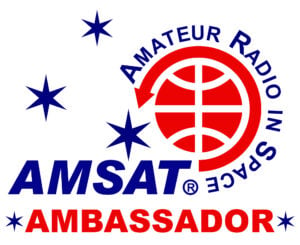
March 22, 2025
Midwinter Madness Hamfest
Buffalo Civic Center
1306 County Rd 134
Buffalo MN 55313
https://k0ltc.org/midwinter-madness/
Hosts: K0JM, AD0HJ, KE0PBR
April 4-5, 2025
Southeastern VHF Conference 2025
Quality Inn
3095 Wilma Rudolph Blvd
Clarksville, TN 37040
Host: W4FCL
April 5, 2025
RARSfest
Jim Graham Building
NC State Fairgrounds
Youth Center Drive, Gate 5
Raleigh NC
https://www.rarsfest.org/index.php
Hosts: K4EB, N4AEW, W1DCM, KK4HG, N4HF
Interested in becoming an AMSAT Ambassador?
AMSAT Ambassadors provide presentations, demonstrate communicating through amateur satellites, and host information tables at club meetings, hamfests, conventions, maker faires, and other events.
For more information go to: https://www.amsat.org/ambassador/
[ANS thanks Bo Lowrey, W4FCL, Director – AMSAT Ambassador Program for the above information.]
Satellite Shorts from All Over
Are the kiddies bored and driving you crazy? Have you read the last issue of the ANS Weekly Bulletins ten times and you still have nine hours to go before the next useable pass of the ISS? How about spending some time with a rocket-oriented coloring book? Get your kids and their crayons out and navigate to https://mondaymandala.com/rocket-coloring-pages. Here you’ll find 24 printable coloring book pages with ready-to-color images of everything from the Space Shuttle, SLS, Soyuz, SpaceX Heavy and so much more. What? Done already? Go to https://mondaymandala.com/astronaut-coloring-pages/ for another twenty coloring book pages of astronauts! Did you color out of the lines? No worry. Print as many pages as you like. These pages are totally FREE! [ANS thanks mondaymanda.com for the above information.]
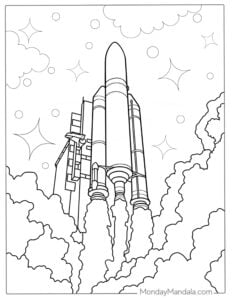
Run out of crayons? Time to sit back and relax with one or two of sixteen NEW videos of the 2023 AMSAT Space Symposium. David Beaujean, N8EPF, has broken the hours-long You Tube videos of two days worth of Symposium presentations into separate, easy-to-click programs. Topics range from CubeSat propulsion systems to space qualified antenna systems and everything in between. David is working on the 2024 Symposium presentations and will be available soon. So, grab a beverage, a bowl of pretzels and navigate to https://tinyurl.com/ANS-068-Videos. Choose from the topics in the right-hand column. Thank you, Dave, for your tireless work in helping to make AMSAT members aware of what AMSAT is doing to Help Keep Amateur Radio in Space! [ANS thanks AMSAT for the above information.]
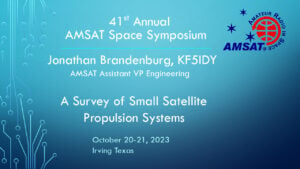
Still looking for something to do? The AMSAT News Service can use one or two more rotating weekly editors to help keep its members and other satellite enthusiasts up-to-date. Rotating Editors are expected to make a commitment of once a month or so to get their issue of the ANS Weekly Bulletin out on time. Each issue basically requires six hours or so of reviewing a variety of news sources, copying and editing published stories into the ANS format. Some weeks or chock full of news and some are on the thin side so a bit of original writing maybe be needed. You’ll work with a small group of fellow editors trading stories and pitching in. If you want more information or want to talk to Mark Johns, K0JM, AMSAT News Service Editor-in-Chief, drop a note at volunteer [at] amsat [dot] org. and we’ll get you connected.
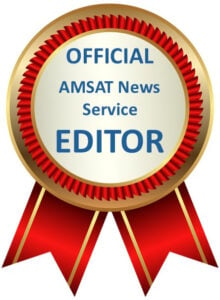
Join AMSAT Today at https://launch.amsat.org/
In addition to regular membership, AMSAT offers membership to:
- Societies (a recognized group, clubs or organization).
- Primary and secondary school students are eligible for membership at one-half the standard yearly rate.
- Post-secondary school students enrolled in at least half time status shall be eligible for the student rate for a maximum of 6 post-secondary years in this status.
- Memberships are available for annual and lifetime terms.
Contact info [at] amsat [dot] org for additional membership information.
73 and remember to help Keep Amateur Radio in Space!
This week’s ANS Editor, Frank Karnauskas, N1UW
f.karnauskas [at] amsat [dot] org

